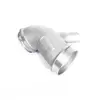Mobile:+86-311-808-126-83
Email:info@ydcastings.com
Understanding the Role of Impellers in Submersible Pump Performance and Efficiency
The Role of Impellers in Submersible Pumps
Submersible pumps are essential devices employed in various applications, ranging from agricultural irrigation to municipal water supply systems. One of the key components that determine the efficiency and performance of these pumps is the impeller. Understanding the role of the impeller in submersible pumps is crucial for selecting the right pump for specific tasks and ensuring optimal operation.
What is an Impeller?
An impeller is a rotating component within a pump that transfers energy from the motor to the fluid, effectively increasing the fluid's velocity and creating flow. In submersible pumps, the impeller is typically housed within a sealed casing, submerged underwater, and is designed to function efficiently in various fluid conditions. The impeller's design profoundly influences the pump's performance, efficiency, and application suitability.
Types of Impellers
There are several types of impellers used in submersible pumps, with designs catering to different operational needs. The most common types include
1. Open Impellers These consist of vanes mounted on a hub without any covering. Open impellers are effective for handling fluids with suspended solids and are easy to clean. However, they may not be as efficient in generating high pressures.
2. Closed Impellers These have vanes located between two shrouds, which helps in achieving better hydraulic efficiency and higher pressure generation. Closed impellers are typically employed in applications requiring the pumping of clean fluids.
impeller in submersible pump

3. Semi-Open Impellers This design combines the features of both open and closed impellers. They work well with fluids that have minimal solids, offering a good balance of efficiency and ease of maintenance.
Working Principle
When the motor of a submersible pump operates, it spins the impeller at high speeds. This rotation generates a centrifugal force that pushes the fluid outward from the center of the impeller. As the fluid moves through the impeller, its velocity is increased, converting mechanical energy into kinetic energy. Subsequently, this kinetic energy is transformed into pressure energy as the fluid exits the pump, which enables it to rise to the desired height.
Importance of Impeller Design
The design of the impeller must match the characteristics of the fluid it will handle. Factors such as viscosity, density, and presence of particulates greatly influence the selection of the impeller type and size. A well-designed impeller can minimize energy consumption, enhance flow rates, and reduce wear and tear, leading to longer operational life and lower maintenance costs.
Moreover, the material of the impeller is also a critical aspect. For example, impellers made from stainless steel or bronze are ideal for harsh environments, such as corrosive or abrasive fluids, while plastic impellers may be suitable for less demanding applications.
Conclusion
In summary, the impeller is a vital component of submersible pumps, playing a crucial role in the effective movement of fluid. Its design significantly impacts the pump's efficiency and suitability for various applications. Understanding the different types of impellers and their functionalities will aid in making informed decisions when selecting submersible pumps for specific needs. As technology advances, innovations in impeller design continue to enhance the efficiency and reliability of submersible pumps, solidifying their place as indispensable equipment in numerous industries.
-
Why Should You Invest in Superior Pump Castings for Your Equipment?NewsJun.09,2025
-
Unlock Performance Potential with Stainless Impellers and Aluminum End CapsNewsJun.09,2025
-
Revolutionize Your Machinery with Superior Cast Iron and Aluminum ComponentsNewsJun.09,2025
-
Revolutionize Fluid Dynamics with Premium Pump ComponentsNewsJun.09,2025
-
Optimizing Industrial Systems with Essential Valve ComponentsNewsJun.09,2025
-
Elevate Grid Efficiency with High-Precision Power CastingsNewsJun.09,2025











